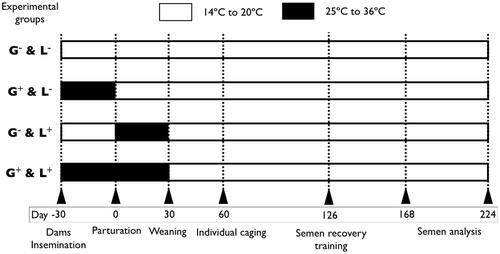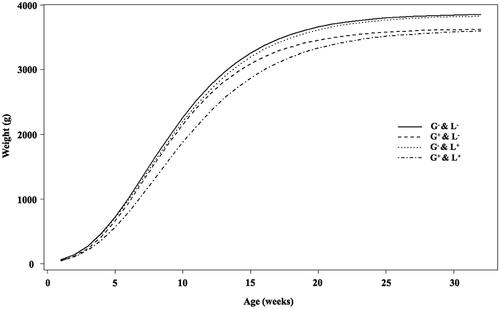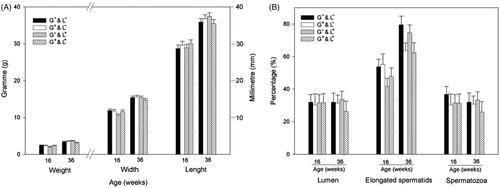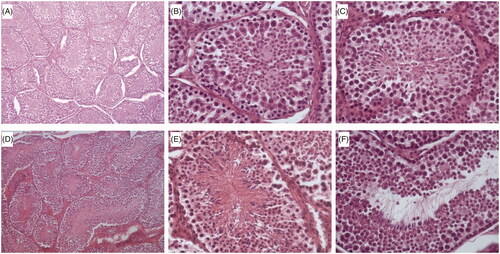Figures & data
Figure 1. Schematic illustration of gestation and lactation period and time of exposure to high temperatures in the experimental groups. G−&L−, control animals raised in standard laboratory temperatures during both gestation and lactation; G+&L−, animals exposed to high temperatures during gestation; G−&L+, animals exposed to high temperatures during lactation; G−&L+, animals exposed to high temperatures during both gestation and lactation.

Figure 2. Representative images of haematoxylin and eosin stained sections from rabbit seminiferous tubules. (A) and (B) seminiferous tubules without a lumen; (C) seminiferous tubules without a lumen with presence of spermatids in the seminiferous epithelium; (D) seminiferous tubules without a lumen; (E) presence of spermatids in the seminiferous epithelium; (F) presence of spermatozoa in the lumen of the seminiferous tubules. Microphotographs (A) and (D) were observed under a light microscope at ×100. Microphotographs (B), (C), (E) and (F) were observed under a light microscope at ×400.

Table 1. Ejaculates and sperm parameters and motility assessment of male rabbits exposed to high temperatures during pregnancy and the postnatal period.
Table 2. Sperm motility assessment of male rabbits exposed to high temperatures during pregnancy and postnatal period.
Table 3. Serum testosterone levels of male rabbits exposed to high temperatures during gestation and/or lactation at pubertal age (16 weeks old) and mature, sexually active ages (24 and 36 weeks old).
Figure 3. Analysis of testicular histometry and histology of male rabbits exposed to high temperatures during gestation (G+&L−), lactation (G−&L+), both gestation and lactation (G+&L+), and control group (G−&L−) at pubertal age (16 weeks old) and mature, sexually active ages (24 and 36 weeks old). (A) Histometry: testis weight, length and width. (B) Histology: percentage of seminiferous tubules with presence of lumen, percentage of seminiferous tubules with presence of spermatids and the percentage of seminiferous tubules with presence of spermatozoa.

Table 4. Fertility and prolificacy of male rabbits exposed to high temperatures during pregnancy and postnatal period.
Figure 4. Average growth curves estimated with the Gompertz function during the first 36 weeks for male rabbits exposed to high temperatures during gestation (G+&L−), lactation (G−&L+), both gestation and lactation (G+&L+) and control group (G−&L−).

Table 5. Comparison Gompertz growth curve parameters of male rabbits exposed to high temperatures during pregnancy and the postnatal period weighed weekly from 1 to 36 weeks old.
Table 6. Live weight of male rabbits exposed to high temperatures during pregnancy and postnatal period at pubertal age (16 weeks old) and mature, sexually active ages (24 and 36 weeks old).
Table 7. Comparison carcass traits at 36 weeks old of male rabbits exposed to high temperatures during pregnancy and postnatal period..
